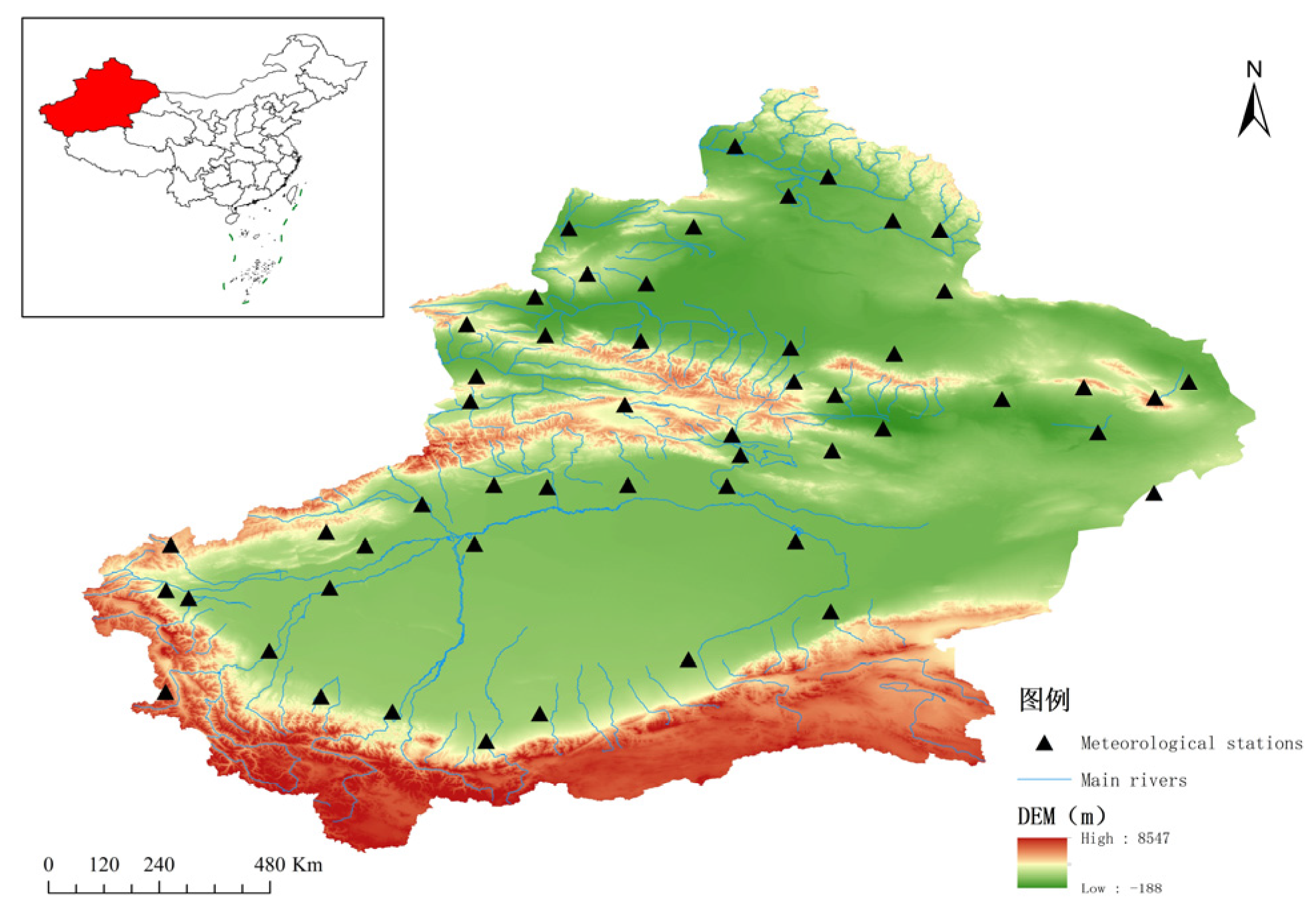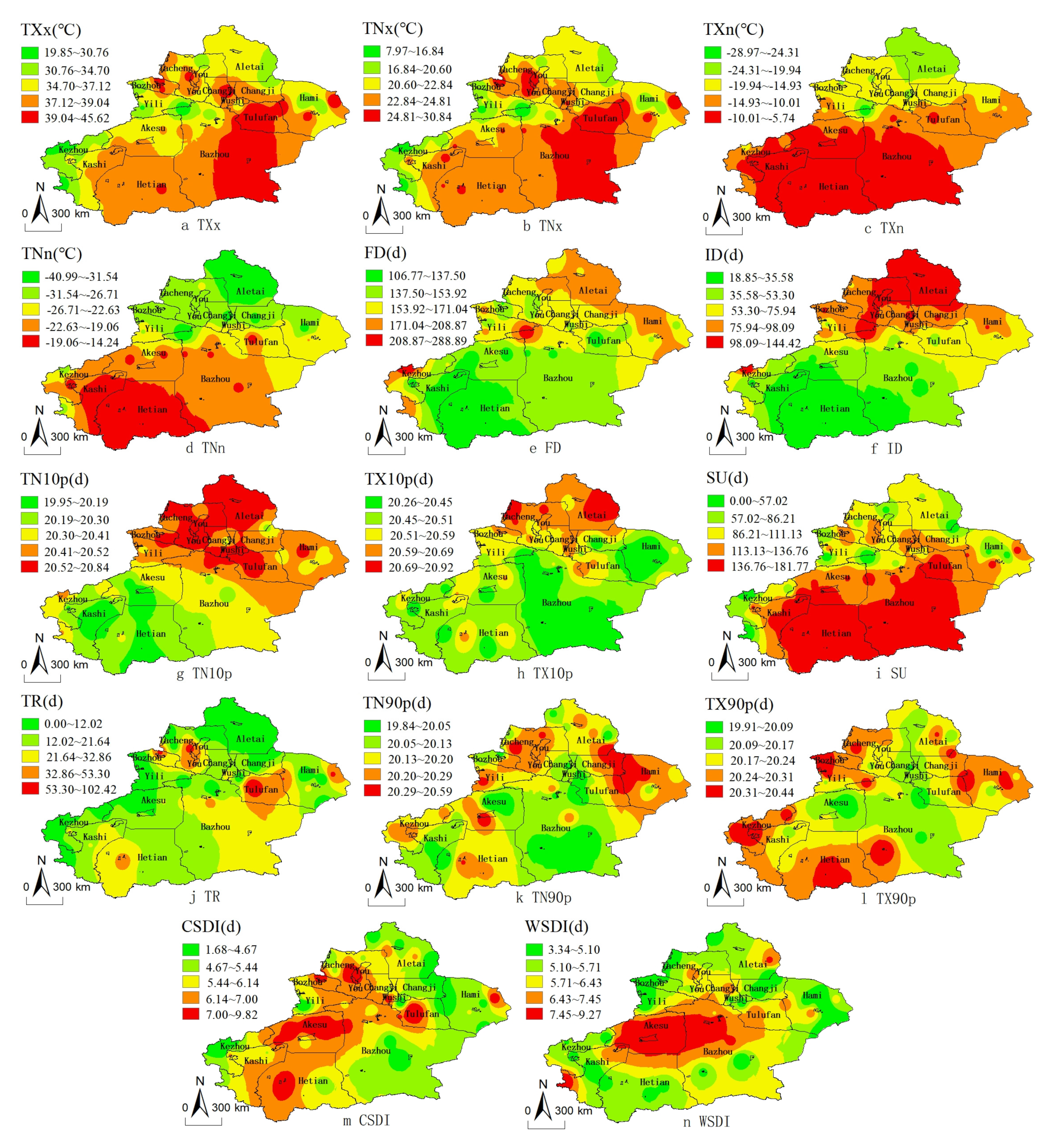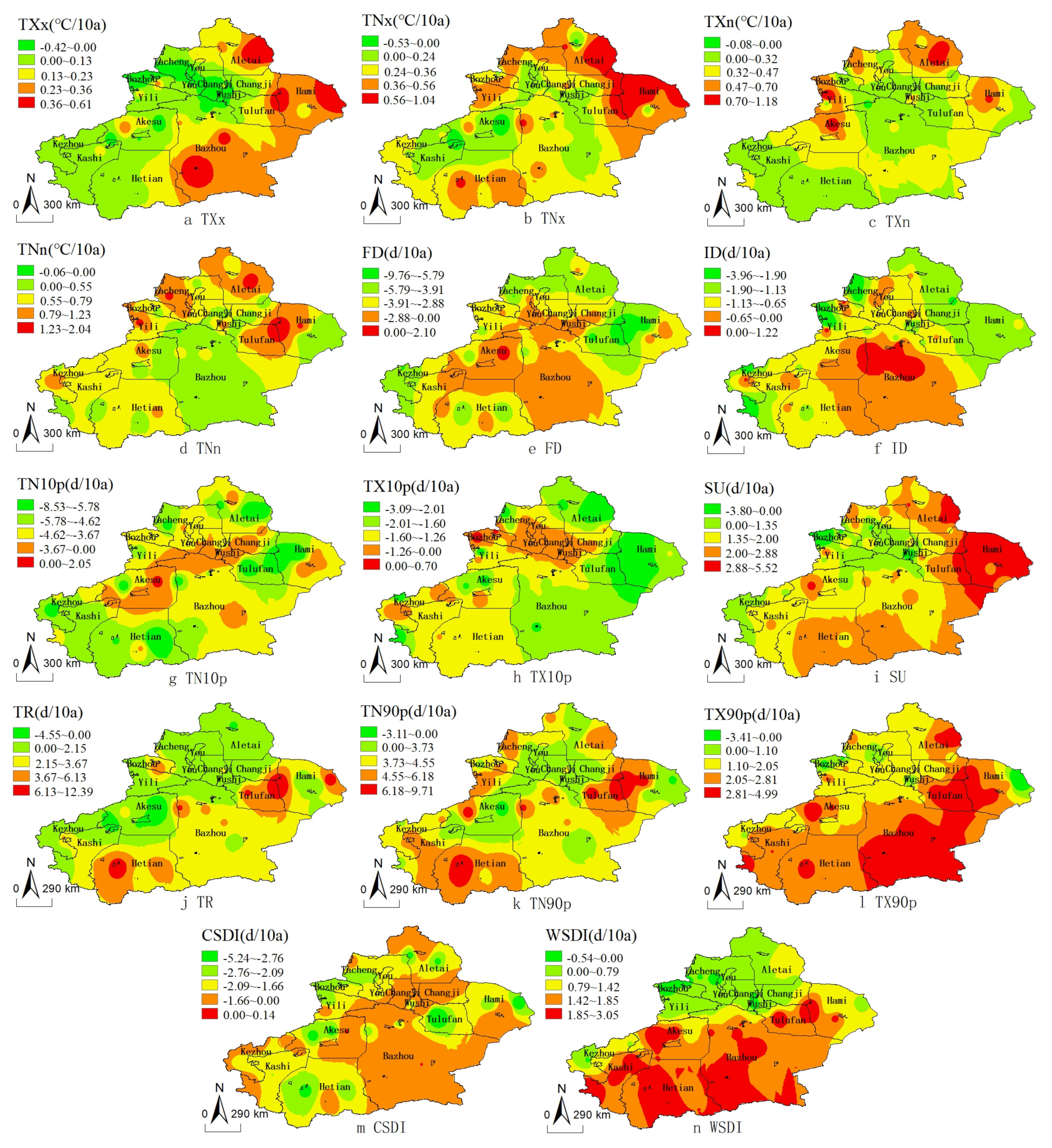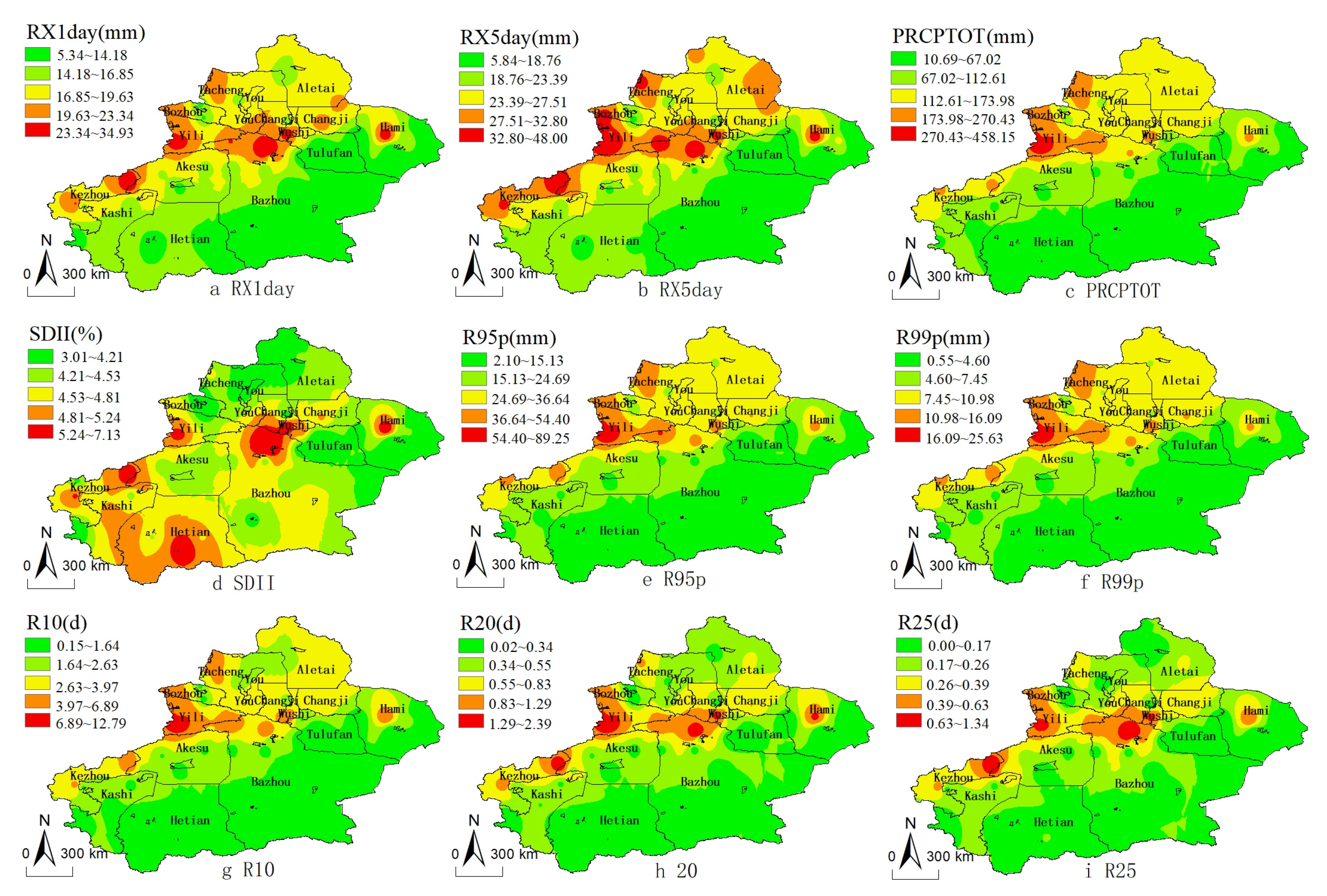Submitted:
28 March 2024
Posted:
28 March 2024
You are already at the latest version
Abstract
Keywords:
1. Introduction
2. Materials and Methods
2.1. Study Area
2.1. Data and Methods
3. Results
3.1. Spatio-Temporal Pattern and Change of Extreme Temperature
3.1.1. Analysis of Time Characteristics
- (1)
- Extreme Value Index
- (2)
- Cold Event Index
- (3)
- Warm Event Index
- (4)
- Persistence Index
3.1.2. Analysis of Spatial Characteristics
- (1)
- Extreme Value Index
- (2)
- Cold Event Index
- (3)
- Warm Event Index
- (4)
- Duration Index
3.2. Spatio-Temporal Pattern and Changes of Extreme Precipitation
3.2.1. Analysis of Temporal Characteristics
- (1)
- Precipitation Scale index
- (2)
- Precipitation Intensity Index
- (3)
- Precipitation Day Index
3.2.2. Analysis of Spatial Characteristics
- (1)
- Precipitation Scale Index
- (2)
- Precipitation Intensity Index
- (3)
- Precipitation Day Index
4. Discussion
5. Conclusions
Author Contributions
Funding
Data Availability Statement
Conflicts of Interest
References
- Doktycz, C.; Abkowitz, M. Loss and Damage Estimation for Extreme Weather Events: State of the Practice. Sustainability 2019, 11, 4243. [CrossRef]
- IPCC. Climate change 2013: Managing the risks of extreme events and disaster to advance climate change adaptation[M]. Cambridge: Cambridge University Press, 2013.
- J R W ,A D P ,E M O ; et al.Practical rare event sampling for extreme weather.[J].Chaos (Wood bury, N.Y.),2019,29(5):053109. [CrossRef]
- Lin Q, Wang Y. Spatial and temporal analysis of a fatal landslide inventory in China from 1950 to 2016[J]. Landslides,2018,15(12): 2357-2372. [CrossRef]
- OLIVER E C J, DONAT M G, BURROWS M T; et al..Longer and more frequent marine heatwaves over the past century [J]. Nature Communications, 2018, 9: 1-12.. [CrossRef]
- Zhang W, Yang X. Extreme weather and climate events :Physical drivers , modeling and impact assessment. Journal of Marine Science and Engineering, 2020,8:448. [CrossRef]
- Centre for Research on the Epidemiology of Disasters (CRED), United Nations Office for Disaster Risk Reduction (UNISDR). The Human Cost of Weather-Related Disasters 1995–2015; UNISDR: Geneva, Switzerland,2015; Volume 30.
- Alexander L V, Zhang X, Peterson T C et al. Global observed changes in daily climate extremes of temperature and precipitation[J]. Journal of Geophysical Research, 2006,111(5):85-109. [CrossRef]
- Founda D, Pierros F, Petrakis M; et al. Variations and trends of the Urban Heat Island in Athens (Greece) and its response to heat waves[J]. Atmospheric Research,2015,161:1-13. [CrossRef]
- Alfieri L,Feyen L, Dottori F,et al. Ensemble flood risk assessment in Europe under high end climate scenarios. Global Environmental Change ,2015,35;199-212. [CrossRef]
- Stott P A, Christidis N, Oto F; et al. Attribution of extreme weather and climate-related events[J]. Wiley Interdisciplinary Reviews Climate Change,2016,7(1):23-41. [CrossRef]
- Wolfgang, K, Petra, L, Zbigniew, W.K. Changes in risk of extreme weather events in Europe. Sci. Policy 2019,100,74–83. [CrossRef]
- Donat M G, Alexander L V, Yang H et al. Updated analyses of temperature and precipitation extreme indices since the beginning of the twentieth century: The HadEX2 dataset[J]. Journal of Geophysical Research:Atmospheres, 2013,118(5):2098-2118. [CrossRef]
- Zhang W, Furtado K,Wu P; et al. Increasing precipitation variability on daily-to-multiyear time scales in a warmer world. Science Advances,2021,7(3): 25-50. [CrossRef]
- Junaid D ,Qayoom A D .The Structure of extreme precipitation and flood events over India in association with integrated water vapor transport from 1980 to 2015[J].Arabian Journal of Geosciences,2023,16(3):. [CrossRef]
- Taye, M.T.; Ntegeka, V.; Ogiramoi, N.P.; Willems, P. Assessment of climate change impact on hydrological extremes in two source regions of the Nile River Basin. Hydrol. Earth Syst. Sci. 2011, 15, 209–222. [CrossRef]
- Shuting Y ,Yali L ,Chong W ; et al.Subseasonal Variations of Convective and Microphysical Characteristics of Extreme Precipitation Over the Pearl River Delta at Monsoon Coast[J].Journal of Geophysical Research: Atmospheres,2023,128(3):. [CrossRef]
- Akshay S ,Muhammed J ,K. S J .Spatial connections in extreme precipitation events obtained from NWP forecasts: A complex network approach[J].Atmospheric Research,2023,282. [CrossRef]
- Kay, A.L.; Davies, H.N.; Bell, V.A.; Jones, R.G. Comparison of uncertainty sources for climate change impacts:Flood frequency in England. Clim. Chang. 2009, 92, 41–63. [CrossRef]
- Shuang L ,Ziniu X ,Lu T .Interannual variation of the number of winter extreme low temperature days in southern China and influencing factors[J].Atmospheric Research,2023,294. [CrossRef]
- Qiu J ,Yang X ,Cao B ; et al.Effects of Urbanization on Regional Extreme-Temperature Changes in China, 1960–2016[J].Sustainability,2020,12(16):. [CrossRef]
- Dongxue F ,Yihui D .The study of changing characteristics of the winter temperature and extreme cold events in China over the past six decades[J].International Journal of Climatology,2021,41(4):2480-2494. [CrossRef]
- Weishou T ,Lian Z ,Yakun D ; et al.Long-Term Variations in Warm and Cold Events in Nanjing, China: Roles of Synoptic Weather Patterns and Urbanization[J].Land,2023,12(1):162-162. [CrossRef]
- GUAN Yinghui, ZHANG Xunchang, ZHENG Fenli; et al.Trends and variability of daily temperature extremes during 1960—2012 in the Yangtze River Basin, China[J]. Global and Planetary Change, 2015, 124: 79-94.. [CrossRef]
- LIU Saiyan, HUANG Shengzhi, XIE Yangyang; et al. Spatialtemporal changes of maximum and minimum temperatures in the Wei River Basin, China: Changing patterns, causes and implications[J]. Atmospheric Research, 2018, 204: 1-11.. [CrossRef]
- Pi Y, Yu Y, Zhang Y; et al.Extreme Temperature Events during 1960—2017 in the Arid Region of Northwest China: Spatiotemporal Dynamics and Associated Large-Scale Atmospheric Circulation[J].Sustainability,2020,12(3):1198-1198. [CrossRef]
- Zhai P M, Sun A J, Ren F M; et al.Change of climate extremes in China[J].Climate Change,1999,42:203-218. [CrossRef]
- YANG Jinhu, JIANG Zhihong, WANG Pengxiang; et al. Spatial and temporal distribution of annual extreme precipitation events in China [J]. Climatic and Environmental Research,2008,13(1):75-83.
- Zhao N , Jiao Y , Ma T ,et al.Estimating the effect of urbanization on extreme climate events in the Beijing-Tianjin-Hebei region, China[J].The Science of the Total Environment, 2019,688(20):1005-1015. [CrossRef]
- Horton M R,Mankin S J,Lesk C; et al. A Review of Recent Advances in Research on Extreme Heat Events[J]. Current Climate Change Reports,2016,2(4). [CrossRef]
- SHU Zhangkang, LI Wenxin, ZhANG Jianyun; et al. Historical Changes and Future Trends of Extreme Precipitation and High Temperature in China [J]. Chinese Engineering Science, 2022, 24 (05): 116-125. [CrossRef]
- Tao J ,Qing W ,Shawei Z .Climate, Human Behavior and Settlement Morphology: A Case Study in Kashigar, Xinjiang Autonomous Region[C].Proceedings of the 11th International Symposium on Environmental Behavior Research,2014:7.
- Fang X ,Liang Y ,Gu J ; et al.Study on Potential Geographical Distribution of Diphtheria Aconitum in Xinjiang under the Scenario of Future Climate Change[J].Academic Journal of Environment Earth Science,2023,5(5):. [CrossRef]
- Kang Ziwei, Zhang Zhengyong, Liu Lin; et al. Analysis of spatiotemporal variation characteristics of surface temperature in Xinjiang based on MODIS [J]. Geographical Research, 2022, 41 (04): 997-1017.
- Chen Yueping, Wu Shengli, Zhao Xin; et al. The spatio-temporal variation characteristics of extreme temperatures in Hami City over the past 60 years [J]. Geography of Arid Areas, 2023,46 (06): 868-879.
- Lv Ting, Wu Shengli, Ge Huanhuan; et al. The spatio-temporal variation characteristics of extreme temperatures in Altay, Xinjiang from 1962 to 2013 [J]. Glacier and permafrost, 2020,42 (03): 745-755.
- Ding Zhiyong, Ge Yongxiao, Jilili Abdu; et al. Change trend of extreme temperature and precipitation in the Ebinur Lake basin in Xinjiang from 1957 to 2012 [J]. Journal of University of the Chinese Academy of Sciences, 2018,35 (02): 160-171.
- Huang Y ,Ma Y ,Liu T ; et al.Climate Change Impacts on Extreme Flows Under IPCC RCP Scenarios in the Mountainous Kaidu Watershed, Tarim River Basin[J].Sustainability,2020,12(5):2090-2090. [CrossRef]
- Tao J ,Qing W ,Shawei Z .Climate, Human Behavior and Settlement Morphology: A Case Study in Kashigar, Xinjiang Autonomous Region[C].Proceedings of the 11th International Symposium on Environmental Behavior Research,2014:7.
- Li Jinglin, Pu Zongchao, Zhang Shanqing, 2018. The impact and zoning of climate change on agriculture in Xinjiang [M]. Beijing: Meteorological Publishing House.
- Xiao-ming C ,Xi C ,An-ming B ; et al.Net Primary Productivity(NPP) of Oasis Changes in Trends in Xinjiang and Responses to Climate Change Analysis in 1981-2000[C].Intelligent Information Technology Application Association,2011:8. [CrossRef]
- Yu Jialu, Zhang Jing, Zhang Min; et al. Spatial and temporal evolution characteristics of drought in Xinjiang based on standardized pre precipitation evapotranspiration index [J]. Agricultural Research in Arid Regions, 2023,41 (04): 275-288.
- Yu Shui, Zhang Xiaolong, Liu Zhijuan; et al. The spatio-temporal variation characteristics of extreme climate index in the Songhua River Basin from 1961 to 2020 [J]. Journal of Applied Ecology, 2023,34 (04): 1091-1101.
- Zhou Yuke, Gao Qi. The Extreme Climate Index Data set of the Qinghai Tibet Plateau from 1960 to 2012 [J]. Chinese Science Data, 2017,2 (02): 70-78.
- Jiang C, Mu X, Wang F; et al. Analysis of extreme temperature events in the Qinling Mountains and surrounding area during 1960-2012[J]. Quaternary International, 2016, 392: 155-167. [CrossRef]
- Yang T ,Shao Q ,Hao Z ; et al.Regional frequency analysis and spatio-temporal pattern characterization of rainfall extremes in the Pearl River Basin, China[J].Journal of Hydrology,2009,380(3/4):386-405. [CrossRef]
- Zhanming L ,Hong Y ,Xinghu W ; et al.Spatiotemporal Variation in Extreme Precipitation in Beijiang River Basin, Southern Coastal China, from 1959 to 2018[J].Journal of Marine Science and Engineering,2023,11(1):73-73. [CrossRef]
- Zhang Yihui, Liang Kang, Liu Changming; et al. The spatiotemporal distribution characteristics and possible causes of extreme climate in the Niyang River Basin [J]. Geographical Research, 2022, 41 (10): 2808-2820.
- Luo M ,Liu T ,Meng F ; et al.Proportional coefficient method applied to TRMM rainfall data: Case study of hydrological simulations of the Hotan River Basin (China)[J].Journal of Water and Climate Change,2017,8(4):627-640. [CrossRef]
- Zhang Q ,Gu X ,Singh P V ; et al.Magnitude, frequency and timing of floods in the Tarim River basin, China: Changes, causes and implications[J].Global and Planetary Change,2016,139,44-55. [CrossRef]
- Guoying Z ,Xinyi Z .Changes of extreme climate indices on the Mongolian Plateau during 1981-2020 based on ERA5 reanalysis[J].Theoretical and Applied Climatology,2023,154(1-2):467-482. [CrossRef]
- Jieming C ,Weixing Z ,Jiangnan L ; et al.Changes in Extreme Climate Events in Rice-Growing Regions Under Different Warming Scenarios in China#13;[J].Frontiers in Earth Science,2021,9. [CrossRef]
- Zhang J ,Wang F .Changes in the Risk of Extreme Climate Events over East Asia at Different Global Warming Levels[J].Water,2019,11(12):2535. [CrossRef]
- Xu Yongbing, Lei Qiuliang, Zhou Jiaogen; et al. Study on the Characteristics of Extreme Climate Index Changes in Yunnan Province from 1960 to 2015 [J]. China Agricultural Resources and Regionalization, 2020,41 (11): 15-27.
- Huang I, Yu H, Guan X et al. Accelerated dry land expansion under climate change[J]. Nature Climate Change,2016(6):166-171. [CrossRef]
- Zhang P, Ren G, Xu Y et al. Observed changes in extreme temperature over the global land based on a newly developed station daily dataset[J]. Journal of Climate,2019,32(24):8489-8509. [CrossRef]
- Zhou B, Xu Y, Wu J et al. Changes in temperature and precipitation extreme indices over China: Analysis of a high resolution grid dataset[J]. International Journal of Climatology,2016,36(3):1051-1066. [CrossRef]
- Hou Chengzhi, Huang Danqing, Guidong Wei; et al. Characteristics and influencing factors of extreme climate change in deserts and deserts in northern China from 1961 to 2019 [J]. Geographic Science, 2023,43 (08): 1495-1505.
- Wang Baolong, Zhang Mingjun, Wei Junlin; et al. Changes in extreme events of temperature and precipitation in the northwest region over the past 50 years [J]. Journal of Natural Resources, 2012,27 (10): 1720-1733.
- Chen Qi, Mao Fangjie, Du Huaqiang; et al. The spatiotemporal evolution of subtropical extreme precipitation in China and its impact on potential net primary productivity [J]. Journal of Ecology, 2022, 41 (11): 2117-2127.





| Categories | Name | Indexes | Definition | Unit |
|---|---|---|---|---|
| Extreme Value Index | Daily Maximum Temperature Maximum | TXx | The maximum daily maximum temperature within each year | ℃ |
| Daily Minimum Temperature Maximum | TNx | The maximum daily minimum temperature within each year | ℃ | |
| Daily Maximum Temperature Minimum | TXn | The minimum daily maximum temperature within each year | ℃ | |
| Daily Minimum Temperature Minimum | TNn | The minimum daily minimum temperature within each year | ℃ | |
| Cold Event Index | Frost Day | FD | Annual count when Tmin < 0℃ | d |
| Frozen Day | ID | Annual count when Tmax < 0℃ | d | |
| Cold Night | TN10p | Number of days when Tmin < 10% percentile | d | |
| Cold Daytime | TX10p | Number of days when Tmax <10% percentile | d | |
| Warm Event Index | Summer Day | SU | Annual count when Tmax > 25℃ | d |
| Hot Nights | TR | Annual count when Tmin >20℃ | d | |
| Warm Night | TN90p | Number of days when Tmin > 90th percentile | d | |
| Warm Daytime | TX90p | Number of days when Tmax > 90th percentile | d | |
| DurationIndex | Cold Duration | CSDI | Annual count of days with at least 6 consecutive days when Tmin < 10th percentile | d |
| Heat Duration | WSDI | Annual count of days with at least 6 consecutive days when Tmax > 90th percentile | d | |
| Precipitation Scale Index | Maximum 1-day Precipitation | Rx1day | Maximum daily precipitation | mm |
| Maximum 5-day Precipitation | Rx5day | Maximum precipitation for 5 consecutive days | mm | |
| Annual Precipitation | PRCPTOT | Total precipitation on rainy days | mm | |
| Precipitation Intensity Index | Precipitation Intensity | SDII | Annual precipitation divided by rainy days | % |
| Intense Precipitation | R95p | Total amount of precipitation > 95th percentile | mm | |
| Extreme Precipitation | R99p | Total amount of precipitation > 99th percentile | mm | |
| Precipitation Day Index | Moderate Precipitation | R10 | Annual count when precipitation of 10-20mm | d |
| Heavy Precipitation | R20 | Annual count when precipitation of 20-25mm | d | |
| Rainstorm Precipitation | R25 | Annual count when precipitation ≥25mm | d |
| Categories | Name | Indexes | Minimum value | Maximum value | Average | B | B | B |
|---|---|---|---|---|---|---|---|---|
| 1960-1989. | 1990-2021. | |||||||
| Extreme Value Index | Daily Maximum Temperature Maximum | TXx | 34.18 | 38.78 | 36.42 | 0.014*** | 0.010 | 0.036*** |
| Daily Minimum Temperature Maximum | TNx | 20.65 | 24.93 | 22.43 | 0.034*** | 0.026*** | 0.044*** | |
| Daily Maximum Temperature Minimum | TXn | 18.78 | 9.30 | 13.51 | 0.037*** | 0.074*** | 0.039 | |
| Daily Minimum Temperature Minimum | TNn | 29.72 | 20.97 | 24.92 | 0.068*** | 0.111*** | 0.001 | |
| Cold Event Index | Frost Day | FD | 141.02 | 176.54 | 158.49 | 0.347 | 0.112 | 0.441 |
| Frozen Day | ID | 52.69 | 88.56 | 67.76 | 0.102 | 0.018 | 0.127*** | |
| Cold Night | TN10p | 8.26 | 43.97 | 21.18 | 0.395 | 0.421 | 0.218 | |
| Cold Daytime | TX10p | 11.11 | 33.47 | 21.26 | 0.106 | 0.050 | 0.040 | |
| Warm Event Index | Summer Day | SU | 95.73 | 124.04 | 110.78 | 0.185*** | 0.045 | 0.238*** |
| Hot Nights | TR | 10.62 | 26.85 | 17.59 | 0.203*** | 0.084*** | 0.337*** | |
| Warm Night | TN90p | 4.52 | 42.81 | 19.94 | 0.207*** | 0.123*** | 0.495*** | |
| Warm Daytime | TX90p | 6.17 | 35.10 | 20.07 | 0.412*** | 0.026 | 0.235*** | |
| Duration Index | Cold Duration | CSDI | 0.35 | 21.90 | 5.80 | 0.170 | 0.179 | 0.008 |
| Heat Duration | WSDI | 0.65 | 17.08 | 5.95 | 0.113*** | 0.000 | 0.151*** |
| Categories | Name | Indexes | Significant | uptrend | Significant uptrend | decline | Significant decline | 0 value |
|---|---|---|---|---|---|---|---|---|
| Extreme Value Index | Daily Maximum Temperature Maximum | TXx | 78.85 | 42 | 34 | 10 | 7 | |
| Daily Minimum Temperature Maximum | TNx | 88.46 | 49 | 44 | 3 | 2 | ||
| Daily Maximum Temperature Minimum | TXn | 82.69 | 51 | 43 | 1 | 0 | ||
| Daily Minimum Temperature Minimum | TNn | 92.31 | 51 | 48 | 1 | 0 | ||
| Cold Event Index | Frost Day | FD | 98.08 | 1 | 1 | 51 | 50 | |
| Frozen Day | ID | 63.46 | 7 | 2 | 45 | 31 | ||
| Cold Night | TN10p | 100.00 | 1 | 1 | 51 | 51 | ||
| Cold Daytime | TX10p | 96.15 | 1 | 1 | 51 | 49 | ||
| Warm Event Index | Summer Day | SU | 94.12 | 47 | 46 | 4 | 2 | 1 |
| Hot Nights | TR | 95.83 | 44 | 43 | 4 | 3 | 4 | |
| Warm Night | TN90p | 96.15 | 50 | 49 | 2 | 1 | ||
| Warm Daytime | TX90p | 94.23 | 47 | 47 | 5 | 2 | ||
| Duration Index | Cold Duration | CSDI | 88.46 | 3 | - | 49 | 46 | |
| Heat Duration | WSDI | 84.62 | 45 | 41 | 7 | 3 |
| Categories | Name | Indexes | Minimum value | Maximum | Average | B | B | B |
|---|---|---|---|---|---|---|---|---|
| 1960-1989. | 1990-2021 | |||||||
| Precipitation Scale Index | Maximum 1-day Precipitation | Rx1day | 12.59 | 23.93 | 17.26 | 0.072*** | 0.061*** | 0.002 |
| Maximum 5-day Precipitation | Rx5day | 15.93 | 35.33 | 24.39 | 0.124*** | 0.077*** | 0.037* | |
| Annual Precipitation | PRCPTOT | 60.57 | 192.54 | 114.20 | 1.322*** | 1.495*** | 0.599*** | |
| Precipitation Intensity Index | Precipitation Intensity | SDII | 3.65 | 5.25 | 4.52 | 0.001 | 0.010 | 0.002 |
| Intense Precipitation | R95p | 10.22 | 57.46 | 24.82 | 0.316*** | 0.208*** | 0.146*** | |
| Extreme Precipitation | R99p | 1.88 | 21.74 | 7.46 | 0.113*** | 0.061*** | 0.044** | |
| Precipitation Day Index | Moderate Precipitation | R10 | 1.06 | 4.96 | 2.57 | 0.031*** | 0.025*** | 0.020*** |
| Heavy Precipitation | R20 | 0.21 | 1.29 | 0.53 | 0.007*** | 0.003* | 0.003** | |
| Rainstorm Precipitation | R25 | 0.06 | 0.67 | 0.25 | 0.004*** | 0.002*** | 0.001 |
| Categories | Name | Indexes | Significant | uptrend | Significant uptrend | decline | Significant decline | 0 value |
|---|---|---|---|---|---|---|---|---|
| Precipitation Scale Index | Maximum 1-day Precipitation | Rx1day | 69.23 | 44 | 32 | 8 | 4 | |
| Maximum 5-day Precipitation | Rx5day | 73.08 | 46 | 35 | 6 | 3 | ||
| Annual Precipitation | PRCPTOT | 98.08 | 50 | 49 | 2 | 1 | ||
| Precipitation Intensity Index | Precipitation Intensity | SDII | 57.69 | 23 | 15 | 29 | 15 | |
| Intense Precipitation | R95p | 80.77 | 45 | 37 | 7 | 5 | ||
| Extreme Precipitation | R99p | 63.46 | 38 | 27 | 14 | 6 | ||
| Precipitation Day Index | Moderate Precipitation | R10 | 88.46 | 49 | 44 | 3 | 2 | |
| Heavy Precipitation | R20 | 73.08 | 41 | 31 | 11 | 7 | ||
| Rainstorm Precipitation | R25 | 63.46 | 37 | 24 | 14 | 9 | 1 |
Disclaimer/Publisher’s Note: The statements, opinions and data contained in all publications are solely those of the individual author(s) and contributor(s) and not of MDPI and/or the editor(s). MDPI and/or the editor(s) disclaim responsibility for any injury to people or property resulting from any ideas, methods, instructions or products referred to in the content. |
© 2024 by the authors. Licensee MDPI, Basel, Switzerland. This article is an open access article distributed under the terms and conditions of the Creative Commons Attribution (CC BY) license (http://creativecommons.org/licenses/by/4.0/).




